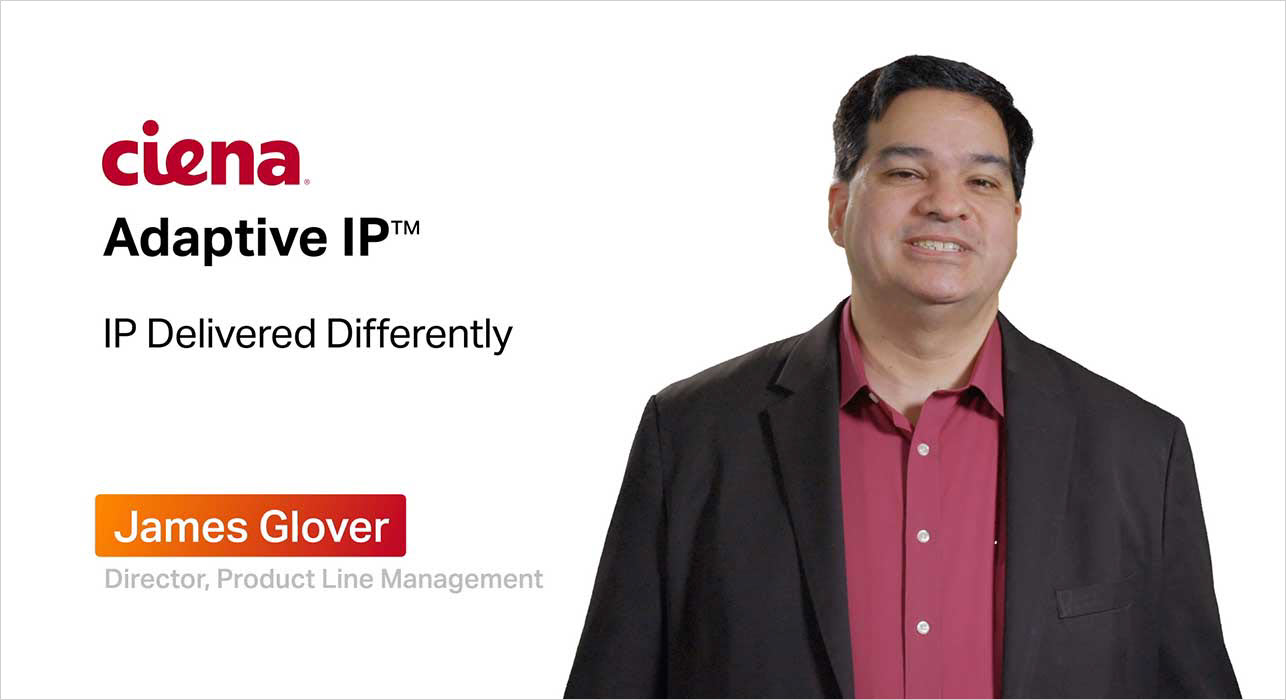Unlocking your access fiber with universal aggregation
In part one, of this two-part blog series on universal aggregation, I discussed how universal aggregation could help controlled network operators capital expensive (CAPEX), where the network operator owns the fiber infrastructure. In this blog, I’ll discuss how universal aggregation assists operational expenses (OPEX), where the network operator leases the feeder infrastructure.
When deciding to connect to fiber, there are several options to consider. Network operators can use a fully managed lit fiber service from an access provider or use different types of dark fiber – for their own (unique) transport service. There are three main types:
- Leased lit fiber
- Leased dark fiber
- Self-provisioned
 Lease lit fiber is where the local provider owns, activates, and manages for a fee. This type of service is well known/used for Ethernet Business Services (EBS), Layer 2 (L2), and Layer 3 (L3) services.
Lease lit fiber is where the local provider owns, activates, and manages for a fee. This type of service is well known/used for Ethernet Business Services (EBS), Layer 2 (L2), and Layer 3 (L3) services.
 Leased dark fiber is where network operators, lease a specific number of fiber strands from the local access fiber provider. In the dark fiber example, the network operator owns terminating and/or line equipment. The advantages of leased dark fiber over leased lit fiber are scale and cost.
Leased dark fiber is where network operators, lease a specific number of fiber strands from the local access fiber provider. In the dark fiber example, the network operator owns terminating and/or line equipment. The advantages of leased dark fiber over leased lit fiber are scale and cost.
 Finally, a self-provisioned network is where a customer or agency pays a local fiber provider to build the fiber network, in which they own, operate, and maintain. This example is often used to serve economically challenged business case models for local operators.
Finally, a self-provisioned network is where a customer or agency pays a local fiber provider to build the fiber network, in which they own, operate, and maintain. This example is often used to serve economically challenged business case models for local operators.
Leased fiber lines provide a shared (PON) or dedicated data connection by sending light over fiber optic cables. When it comes to Passive Optical Network (PON) some local fiber access providers can be:
- Subdivisions & communities
- Electric Co-operatives
- Cities & Towns
By deploying a pluggable mixed PON/active architecture based on Ciena’s universal aggregation platforms, 3900 and 5100 families, over long feeders, these network operators will achieve:
- A significant leased feeder fiber OPEX savings
- PON reach extension
This business case model employs Ciena 5100 Family of Switching products to quantify the leased feeder fiber OPEX savings achieved and determines the feeder distances at which the pluggable mixed PON/active architecture becomes more cost-effective, versus the traditional PON architecture for different optical splitting ratios: 1->N (where N = 32, 64, or 128) of a 10G PON.
Making the case for low-cost high bandwidth
In most typical PON deployments, an Optical Line Terminal (OLT) chassis is deployed in a central office or controlled environment, and then passively connected (using a feeder fiber cable) to Optical Network Units (ONU). This can be accomplished with Ciena’s 10G PON transceiver in the 5170 as shown below.
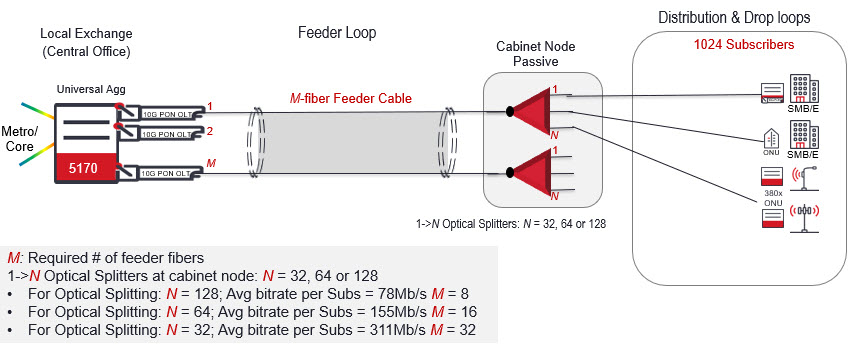
Central Office universal aggregation deployment
Ciena’s cost-effective single rack 5170 doesn’t restrict or limit OLT transceiver port placement, so thousands of customers can be supported. However, for use case consistency, 1024 customers are used. Each Ciena OLT transceiver can support up to 128 connections (connections can be residential, Small Office/Home Offices (SOHOs), SMB/E, mobility, etc.) using passive optical splitters (1:32, 1:64, 1:128).
As shown above the required number of feeder fibers (8, 16, 32), and leased fiber OPEX increases as feeder length and/or bandwidth increases. Deploying 8 fibers can provide 128 customers each with 78Mb/s, 16 fibers can provide 64 customers 155 Mbps, and 32 fibers can provide 32 customers 311Mb/s.
To reduce fiber feeder OPEX costs even more network operators can deploy the 5170 to a remote environmentally controlled cabinet or use Ciena’s 5171 with coherent optics enabling extended temperatures and deployment hundreds of kilometers away.
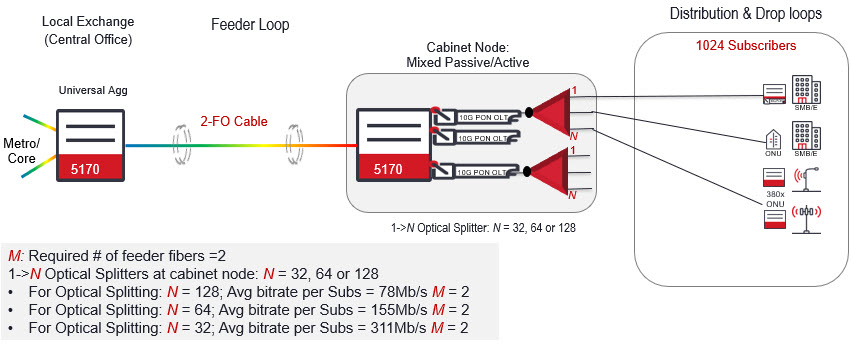
Cabinet based universal aggregation deployment
In the cabinet deployment, the number of feeder fibers (2) remains constant, freeing up valuable feeder fiber assets, and leased feeder fiber OPEX increases only marginally as feeder length and/or delivered bitrates increase. Distribution and drop fibers can remain unchanged.
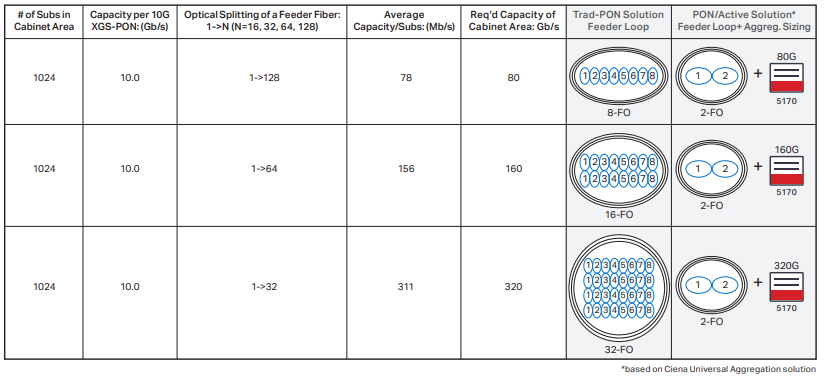
Sizing Ciena’s UA capacity requirement for different optical split ratios
OPEX cost modeling and savings
Both traditional and cabinet based universal aggregation deployments (shown below) have network OPEX cost components that can include:
(i) CO/OLT node: electronics: 10G PON OLT, Ciena 5170, software and power
(ii) Feeder loop: Lease OPEX: $236 / fiber strand / km / year
(iii) Cabinet node: optical splitters, electronics: 10G PON OLT, Ciena 5170, power, enclosure, Controlled Environmental Vault (CEV) to house active electronics
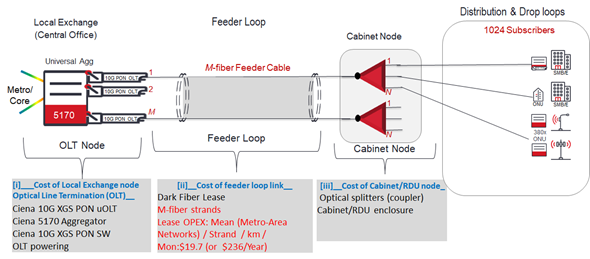
Network cost components of traditional PON FTTx architecture
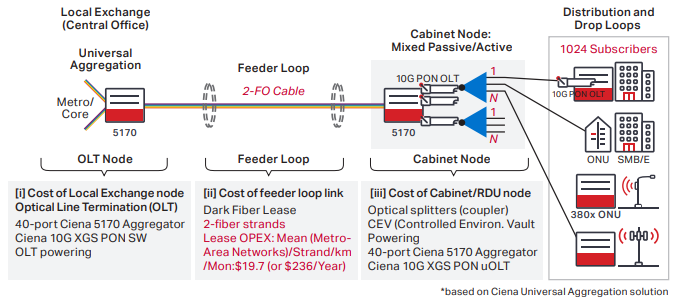
Network cost components of mixed PON/active FTTx architecture based on Ciena’s UA platform
As shown below, significant OPEX savings can be provided using mixed PON/active versus traditional PON deployments for different optical split ratios for feeder (CO to cabinet) distance, in network operators lease feeder infrastructure. To summarize:
- For optical split of feeder fiber: 1->128 (average bitrate/subscriber: 77.8 Mb/s): the mixed PON/active architecture becomes more cost-effective at a feeder distance of 8.9km and results in a cumulative leased feeder fiber OPEX savings of 5.1 and 32% at feeder lengths of 10 and 20km, respectively.
- For optical split of feeder fiber: 1->64 (average bitrate/subscriber: 155.5 Mb/s): the mixed PON/active architecture becomes more cost-effective at a feeder distance of 3.8km and results in cost savings of 39.3 and 59.6% at feeder lengths of 10 and 20km, respectively.
- For optical split of feeder fiber: 1->32 (average bitrate/subscriber: 311 Mb/s): the mixed PON/active architecture becomes more cost-effective at a feeder distance of 1.8km and results in cost savings of 61 and 75.4% at feeder lengths of 10 and 20km, respectively.
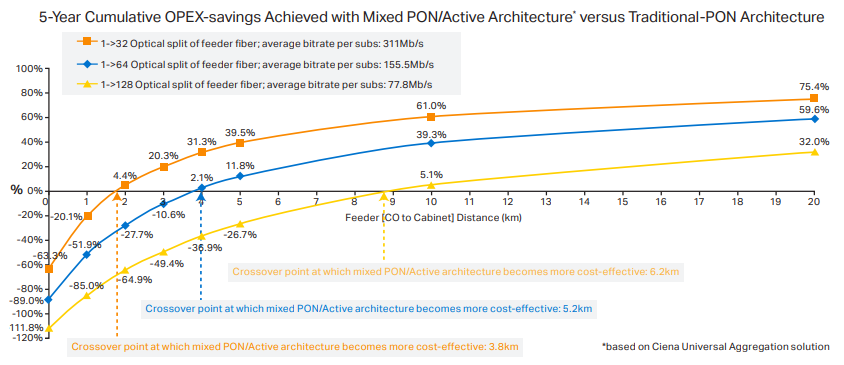
5-Year Cumulative Leased feeder fiber OPEX-savings
Huge savings in leased feeder fiber OPEX, shown below, can be achieved with mixed PON/active architecture based on Ciena’s UA platform. It’s estimated the actual dollar values for a network with 100,000 customers and 1->32 optical split ratio and for feeder distances of 5, 10 and 20km. OPEX for leased feeder dark fiber was: $236 / strand / km / year – which is conservative in metro area networks.
- At a feeder of 5km the leased feeder fiber OPEX savings achieved for 100,000 customers with mixed PON/active architecture based on Ciena’s UA platform is: $2.2M annually and a cumulative $11.1M over 5 years
- At a feeder of 20km the leased feeder fiber OPEX savings achieved for 100,000 customers with mixed PON/active architecture based on Ciena’s UA platform jumps to $12.6M annually and a cumulative $63M over 5 years

5-Year Cumulative Leased feeder fiber OPEX-savings (1:32 split/100,000 customers)
Instead of building siloed, standalone architectures to support different types of services, operators can now bring more value to their networks by supporting concurrent PON, IP, and Ethernet services on the same Ciena universal aggregation platform.
To find out how to unlock your metro access fiber assets ask us how Ciena helps Evolutionize Your Routing and Switching Network.
What’s in your Network Edge?

